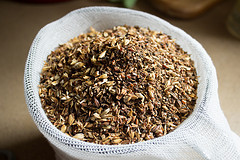FDA Sets Rules For Gluten-Free Food Labels

(ktvorwald) None of that.
In recent years much has been made of gluten — people with celiac disease can’t eat it and others simply want to keep their diets free of it. But until now, there hasn’t been any official word from on high regarding how to actually define what makes a gluten-free food. The Food and Drug Administration is changing that with a final rule on what characteristics a food must have in order to be really and truly gluten-free.
It can be a tough row to hoe for those with celiac disease without such labels, so the FDA is touting the final rule as a way to inspire confidence in the foods they eat.
In order for a food to claim it’s “gluten-free,” the food must contain less than 20 parts per million of gluten. That’s the lowest level most with celiac disease can tolerate in foods, as even very small amounts of gluten can be troublesome. Foods like bottled water, eggs, fruits, and vegetables that inherently don’t contain any gluten can also use the label.
“This standard ‘gluten-free’ definition will eliminate uncertainty about how food producers label their products and will assure people with celiac disease that foods labeled ‘gluten-free’ meet a clear standard established and enforced by FDA,” says Michael R. Taylor, J.D., deputy FDA commissioner for foods and veterinary medicine.
Labels touting foods that are “without gluten,” “free of gluten,” and “no gluten” must also adhere to the same standard.
Since there’s no cure for celiac disease and the only way to deal with it is to keep a gluten-free diet, the American Celiac Disease Alliance is greeting the FDA’s rule with relief.
“This is a tool that has been desperately needed,” says ACDA executive director Andrea Levario. “It keeps food safe for this population, gives them the tools they need to manage their health, and obviously has long-term benefits for them.”
Gluten is a naturally occurring protein in wheat, rye, barley and various hybrids of those grains. As such, the FDA will allow food to be labeled gluten-free if it has below the 20 ppm of gluten. Those with celiac disease cannot absorb the nutrients the body needs, as the disease attacks the lining of the small intestine.
Plenty of products will have to undergo either labeling changes or reformulate their recipes — the FDA says about 5% of foods labeled “gluten-free” currently contain 20 ppm or more of gluten.
For more info, check the FDA’s source link below.
What is Gluten-Free? FDA Has an Answer [FDA.gov]
Want more consumer news? Visit our parent organization, Consumer Reports, for the latest on scams, recalls, and other consumer issues.

